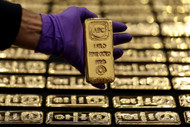Soaring Gold Prices: A Bad Omen for the Dollar?
Jan 04, 2025
Posted by LCR Coin
Soaring Gold Prices: A Bad Omen for the Dollar?
As we step into 2025, hopes for global stability and economic respite are high following the turbulence of 2024. However, market trends paint a different picture—especially when examining the gold market, a clear barometer of economic sentiment. With gold’s meteoric rise, it appears investors are bracing for continued uncertainty and significant geopolitical shifts. This raises a pressing question: what do soaring gold prices signify for the dollar and the global financial system?
A Golden Year for Gold
Gold’s performance in 2024 was nothing short of stellar. Starting the year at $2,046 per ounce, it ended at $2,622, a 28% increase. By comparison, the S&P 500, despite delivering a robust 25% total return, couldn’t outshine gold’s allure. Those who hedged with gold last year saw exceptional returns, solidifying the precious metal’s reputation as a safe haven.
This momentum is set to continue. Major financial institutions, including JP Morgan, Citibank, and Goldman Sachs, predict gold could breach $3,000 an ounce in 2025. These projections are rooted in several factors: lower interest rates, central bank buying, geopolitical instability, and market momentum. Among these, central bank purchases and geopolitical strife have been dominant drivers since early 2023.
Central Banks and the Diversification Dilemma
Central banks are at the heart of the gold rally, with many diversifying away from the US dollar. Since the seizure of Russian assets in 2022, nations have become acutely aware of the risks associated with dollar dependency. Gold, being a neutral reserve asset, has gained favor as a hedge against these risks.
The Asia Times newsletter Global Risk-Reward Monitor forecasts an even more dramatic scenario: gold reaching $10,000 an ounce by 2030. This bold prediction hinges on transformative shifts in global trade systems. The newsletter argues that as nations move away from the dollar, gold could re-emerge as a primary settlement mechanism in international trade. But to fulfill this role, the price of gold must significantly adjust to accommodate the required volumes.
Gold’s Role in a New Global Order
The transition away from dollar hegemony is tied to profound structural changes in the global economy. Countries seeking alternatives to the dollar lack fully developed financial markets capable of supporting widespread bilateral trade in their own currencies. Gold, a universally recognized store of value, provides an effective solution.
Yet, the current gold supply is insufficient to underpin global trade balances at today’s prices. Analysts at Global Risk-Reward Monitor estimate that a $10,000-per-ounce valuation would address this shortage. Such a shift could redefine the global financial landscape, anchoring the international monetary system in gold once again.
Tech Stock Bubble: A Trigger for Dollar Decline?
An intriguing catalyst for this shift could be the collapse of the American tech stock bubble. Over the last decade, US trade deficits have been financed not through traditional government bond sales but by selling tech stocks to foreign investors. Should these stocks experience a dramatic crash, international investors would face heavy losses, prompting them to reassess their reliance on the dollar.
The parallels to the 2000 tech bubble are striking. Back then, despite similar upheavals, the dollar remained unrivaled. Today, however, the geopolitical and economic landscape is far more fractured, with credible alternatives emerging. A retreat from the dollar could further accelerate the ascent of gold, reinforcing its role as a linchpin in global finance.
The Dollar’s Fate: Reflected in Gold’s Rise
The proposition that gold’s price inversely reflects the dollar’s strength gains credence as these dynamics unfold. If gold reaches $10,000 an ounce by 2030, it will not merely signify a bullish trend for the metal but a profound shift in global monetary policy. Such a scenario would validate long-standing arguments that the true measure of the dollar’s value lies in the dollar price of gold.
While forecasts vary, one thing is clear: gold’s ascent tells a story of uncertainty and change. For investors and policymakers alike, the implications of these changes extend well beyond price charts—hinting at a reshaping of the global economic order. As 2025 unfolds, the trends in the gold market are well worth watching, as they may hold the key to understanding the future of the dollar and global stability.

